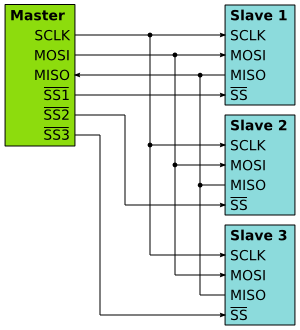I always confuse I²C and SPI, so I decided to create this comparison, and threw in 1-Wire for good measure.
| 1-Wire | I²C | SPI | |
|---|---|---|---|
| Name/Alias | OneWire |
Inter-Integrated Circuit Protocol IIC, I2C Two Wire Interface (TWI) |
Serial Peripheral Interface |
| Oprindelse | Dallas/Maxim | Philips | Motorola |
| Signals | 1-Wire (Data and parasite power) |
SCL (Serial Clock) SDA (Serial Data) |
SCLK (Serial Clock) MOSI (Master Out, Slave In) MISO (Master In, Slave Out) SS (Slave Select) |
| Schematics |  |
 |
 |
| Multiple masters? | No | Yes (if all masters support it) | No |
| Multiple slaves | Yes | Yes | Yes |
| Slave adresses | Unique, 64 bits | 7 or 10 bits | None (one SS-line pr device) |
| Max range | >100m | 2-3m | 0.5m (longer at lower speeds) |
| Max FClock |
Not CLK driven - uses timed pulses. 16.3kbps |
Often 100kHz or 400kHz. 1MHz, 3.4MHz and 5MHz are specified but rarely used. |
10MHz full duplex |
| Bus driver | Open drain | Open drain | Push/Pull/Tri-state |
| Notes | Some slaves can be powered by the 1-Wire data line. Other devices are powered by a normal VCC. | SMBus (defined by Intel in 1995) is a subset of I²C, defining a stricter usage. | Different devices use different clock polarities (CPOL) and clock phase (CPHA) settings. |
| Links |
Overview of 1-Wire Technology and Its Use Guidelines for Reliable Long Line 1-Wire Networks Arduino Playground |
SparkFun I2C Tutorial |
SparkFun SPI Tutorial Better SPI Bus Design in 3 Steps |
No comments:
Post a Comment